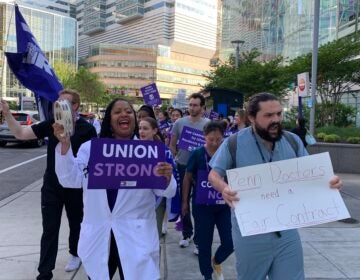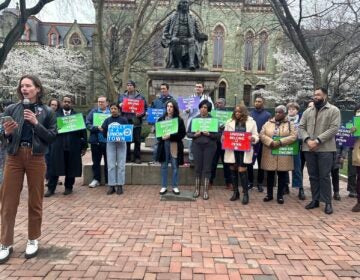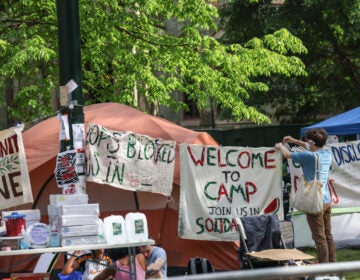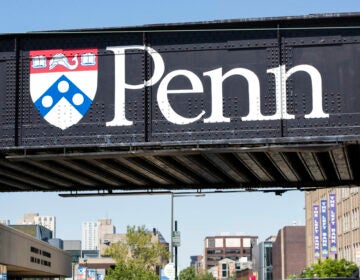Penn grad workers say ‘we’re part of a national movement’ after union win
Graduate student workers voted overwhelmingly to form a union at the University of Pennsylvania, but their first contract could take years.
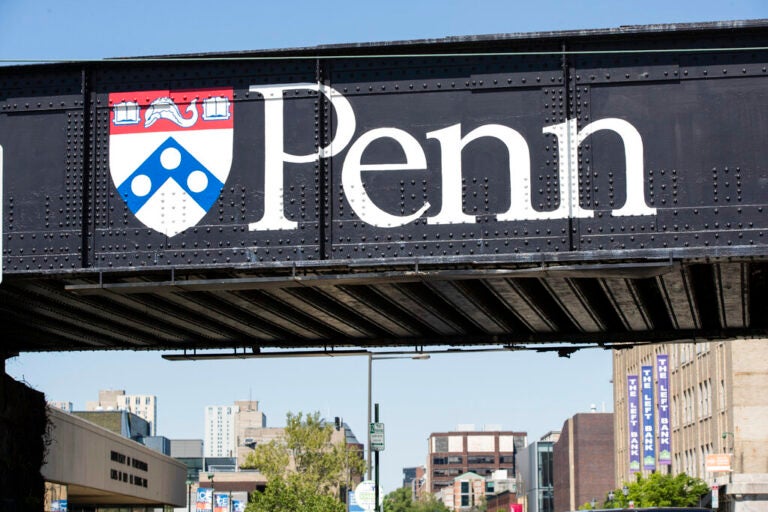
University of Pennsylvania in Philadelphia Wednesday, May 15, 2019. (AP Photo/Matt Rourke)
From Philly and the Pa. suburbs to South Jersey and Delaware, what would you like WHYY News to cover? Let us know!
Thousands of graduate student workers at the University of Pennsylvania — about 97% — voted to unionize in early May.
One of those voters was history and sociology of science six-year PhD candidate Sam Schirvar. The union organizer who works as a teaching assistant and lecturer said he began organizing his colleagues in mid-2020.
Schirvar said it was largely in response to “a lot of frustration to the way Penn handled responding to the COVID-19 pandemic during the early months.”
But the underlying issues have been simmering at the University of Pennsylvania for the past two decades.
“Graduate workers are providing a huge portion of the teaching and research labor that happens at Penn that’s necessary for it to run, and many of us don’t make a living wage,” Schirvar said. “We don’t have any sort of say over our working conditions.”
While exact bargaining details were not available, a proposal for higher pay, better benefits and support for international students will likely be key issues.
The Graduate Employees Together University of Pennsylvania, or GET-UP, is behind the drive to affiliate with the United Auto Workers, which often represents student worker unions.
The union election was scheduled for mid-April but was delayed after the University of Pennsylvania tried to exclude several hundred student workers through the National Labor Relations Board appeal process, but the university failed.
There are about 4,000 eligible graduate student worker voters. There were 1,807 workers who voted in favor of the union, 97 voted against it and there were 417 challenged ballots.
The ultimate size of the union will likely be several thousand workers, but the exact number is expected to fluctuate depending on when student workers graduate or their appointments end.
The university is waiting for official certification of the results by the National Labor Relations Board but recognizes the union election’s unofficial results.
“At Penn, we engage as a community to advance what is important to us all — a dynamic and supportive academic environment,” said Ron Ozio, a spokesperson for the University of Pennsylvania, in a statement. “We look forward to working with representatives from the UAW to continue this important mission for Penn’s graduate and professional students.”
Graduate students at the University of Pennsylvania earn a minimum stipend of $38,000 during the academic year. The biggest increase happened in the past year, when the minimum stipend increased by $8,000.
The university estimates the value of its funding packages for Ph.D. students, which include scholarships to cover tuition and fees, stipends, medical insurance and gym memberships, is $88,244.
Graduate students typically spend about six years working towards their Ph.D. degrees, which means there’ll be turnover in union members.
Dozens of student workers have already graduated in the past four years, but organizers say there’s more behind them ready to step up.
“We’re always bringing in new worker organizers who are in their first or second year. It’s really important for the long-term health of the union at Penn to do that,” Schirvar said.
Nationwide, colleges rely more on graduate student worker labor, said Celine McNicholas, director of policy at the Economic Policy Institute, a non-partisan think tank in Washington D.C.
“Universities have increasingly shifted teaching duties away from those 10-year-track faculty onto graduate students, adjuncts and instructors,” McNicholas said. “That leaves a large portion of the research and teaching at some of the most prestigious universities really being done by folks who are there pursuing their own education.”
There were two previous unionization efforts by GET-UP at the University of Pennsylvania that were not successful.
In 2003, the first unionization effort at the University of Pennsylvania died after the National Labor Relations Board ruled against graduate student unions at private universities. At the time, the federal agency was overseen by the Bush administration.
In 2017, the National Labor Relations Board ruled that all graduate students at the University of Pennsylvania — including those in the business and engineering schools — should be eligible to vote.
By 2018, GET-UP withdrew its union petition during the Trump administration as a strategic move.
Now Trump is on the presidential ballot again this November. It’s unclear what the National Labor Relations Board under Trump may do. But in the past, it ruled against private university student worker unionization efforts. If the University of Pennsylvania and GET-UP don’t ink a contract before those changes, the union could have little recourse about a lack of bargaining in good faith.
But graduate student workers do have some leverage as the lynchpin of the university academic workforce.
“It’s not like Starbucks where you can just close the coffee shop or fire all the baristas and hire more people off the street,” said Ruth Milkman, professor of sociology and labor students at the City University of New York. “Graduate students are highly skilled and not that easily replaced. So that doesn’t mean [the university] won’t drag it out, but that they have some leverage.”
There’s been much more stress about student debt and fewer tenure track jobs waiting for graduate student workers when they graduate.
“That’s been building up for a long time but it’s getting worse,” Milkman said.
There’s some overarching trends that are favorable for the union, low unemployment means workers have more power and the Biden administration’s union-friendly National Labor Relations Board.
“I don’t think young workers are going to put up with the things that previous generations have,” said Paul Clark, labor professor at Penn State.
That’s echoed by University of Pennsylvania organizers.
“I think by and large, young people are starting to see a union as something that is necessary,” Schirvar said. “Prospective graduate students are actively asking about the status of unionization at Penn [during] their campus visit days, they’re taking that into consideration when they’re deciding whether or not they want to go to a particular university.”
Luella Allen-Waller, six-year Ph.D. candidate in biology at Penn, has worked as a teaching assistant, lab instructor and research assistant. She’s been organizing with the group for the past two years.
Waller said students were frustrated with the traditional representation for graduate student workers through volunteer committees that would recommend changes but never have power to require anything.
“It does feel like we’re part of a national movement, as well as part of a really vibrant union movement right now here in Philadelphia, to help make Penn a union workplace,” Allen-Waller said, noting that the new union is among the largest private employer unions in the city.
Columbia University graduate student workers went on strike for 10 weeks before they reached a contract after four years of negotiations. It took Harvard University graduate student workers two years before getting a contract.
The negotiations meant minimum hourly wages went up at both schools to between $20 and $22 an hour and annual raises of 3% for graduate student workers.
The Columbia University deal added $25 million each year to its budget for four yearsl, totaling $100 million to meet union demands. The minimum salary for graduate student workers at Columbia was $41,137 in academic year 2021-2022, according to its union contract.
The Harvard University graduate student worker contract bumped up its salary minimum to $36,672, with higher starting pay for those in life and physical science departments.

Get daily updates from WHYY News!
WHYY is your source for fact-based, in-depth journalism and information. As a nonprofit organization, we rely on financial support from readers like you. Please give today.



